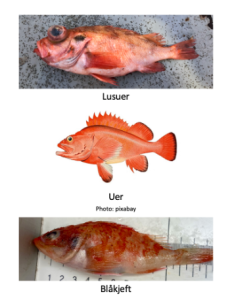
A Bluemouth from the field work. The blue mouth being the explanation for why it is called Bluemouth
When I first started studying molecular biology at the University of Bergen, I quickly realized that I was missing some field work from my bachelor. This jump started my interest for general biology. It also made me question what I really wanted to work with. Unsure of my academic path, I tried several different courses, and eventually tried BIO102, where I was allowed to join other students on a field trip on the ship Kristine Bonnevie. This was the most fun field trip I had all that semester, and I was able to learn more about the oceans surrounding Bergen. I started thinking about marine biology as a possible route for my education. Fast forwarding one year, I’m taking up classes to be able to take marine biology. The course BIO299 always seemed interesting, and this way I would be able to gain some experience in lab work. Little did I know last year that one of the fishes sampled on the field trip in 2021 would be the basis for my entire project in BIO299.

From the field work done in 2021, me with a saithe.
My name is Liv Kristin Knappskog, and I am working with Arild Folkvord and Julie Skadal from the coast and coastal ecology department at UiB. The fish in question is bluemouth (Helicolenus dactylopterus), a fish living on the continental shelf, usually ranging between 200-700 meters. The interesting thing about this fish is that in Norway, we haven’t really researched it at all. This fish is a mystery as it has grown in numbers in our coastal waters, but we are lacking the information as to how it grows and thrives here. Another interesting fact is that we have other fishes that are really similar to bluemouth, so we don’t really know when it came here or how many there are of them.

Can you see the similarity?

Many hours were spent with the defrosted fish in the lab
So, my task in all of this was to measure all the bluemouth that was captured with Kristine Bonnevie (the same boat I was on) from 2021 and 2022. I would also extract their otoliths and take microscopic imagery of them so that we could determine the ages of every sample I had. That seems like a really repetitive task, right? Well, it was, but it was also a really good learning experience for me. And believe it or not, I had a lot of fun while doing this. Something that I wanted to know when I first started doing this was, how do I use the otoliths I extract to determine age?
As you might see from the figure, a. is easy to determine, you just count the darker rings on the otoliths. Obviously, not every otolith pair looks like that. I also had a lot of otolith pairs looking like b. Those pairs usually gave me next to zero clue as to what age they were, which was frustrating. But for the most part, the otolith pairs where something in between a. and b. giving me an approximate estimation that could be used.
A thing that we theorized, was that in warmer countries, the bluemouth grows faster, and will therefore be bigger than the ones we had in the lab. That’s one of the reasons we wanted to find a size-at-age graph for the sampled bluemouth, so that we could see if it was in fact growing slower. And no one has this graph for the bluemouth living on the west coast of Norway, so it is just an entirely new thing in general.
So, what does this information give us? Well, it gives us a basis for drawing further conclusions about this little-known fish. Because we have an estimate for how it grows in our coast, we can use this to predict how it will grow in the years to come. And if we consider the fact that the water is getting warmer and warmer, this information may help with how it will grow if it moves further up. Maybe by doing this for the next ten years, we could see a change in these curves? The habitat off the western coast may change for the better or worse.
This project has left me with more questions than answers, but I am confident that Bluemouth will be more studied around our coast. My Bluemouth project has left me more motivated for studying than ever. And I found something that I think is fun to do. I highly recommend taking this course as it is so much fun, and it involves so much practical learning!

